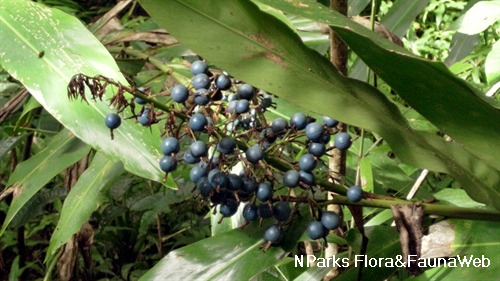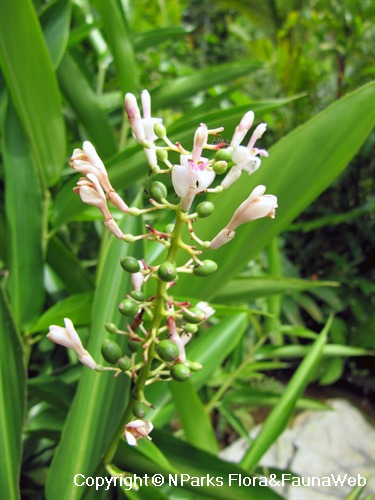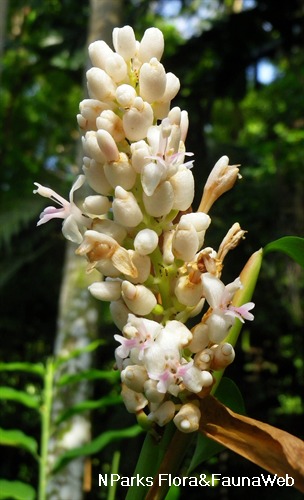.jpg)
Back
Alpinia rugosa S.J.Chen & Z.Y.Chen
| Family Name: | Zingiberaceae |
| Common Name: | Evergreen Broadleaf Ginger |
Alpinia rugosa or Evergreen Broadleaf Ginger is a rhizomatous herb can reach to a height of 1.2 m tall. It has wrinkled elongated leaves and flowers that are white in colour, with an orange lip and pink tubular calyx. The Evergreen Broadleaf Ginger was first discovered in Baoting County, Hainan and known to only exist naturally in Hainan Island.
Name
Classifications and Characteristics
| Plant Division | Angiosperms (Flowering Seed Plants) (Monocotyledon) |
|---|---|
| Plant Growth Form | Herbaceous Plant |
| Lifespan (in Singapore) | Perennial |
| Maximum Height | 1.2 m |
Biogeography
| Native Distribution | Hainan |
|---|---|
| Native Habitat | Terrestrial |
| Preferred Climate Zone | Sub-Tropical / Monsoonal, Tropical |
| Local Conservation Status | Non-native |
Description and Ethnobotany
| Growth Form | It is a rhizomatous herb that produce stem-like stalks (pseudostems) that reaches to 1.2 m in height. |
|---|---|
| Foliage | Its foliage has ruffled or wrinkled (rugose) leaf blades that are elongated and oblong in shape. The leaves are glabrous on the top, pubescent at the bottom. They can measure between 23 - 57 cm long, 5 - 8 cm wide, held on a short hairy petiole of 1 - 5 cm long. |
| Flowers | Its flowers are held on a raceme inflorescence. Flowers are white, tubular with a orange coloured lip, tinged in red emerging from a pink tubular calyx. Each inflorescence is 5 - 11 cm tall, produces up to 20 flowers. |
| Fruit | Its fruits are produced in an elliptic capsule of 1.8 - 2.1 cm by 1.4 - 1.9 cm. The pubescent fruits are yellow in colour when matured. |
| Habitat | It occurs in shaded wet areas in valley forests, 600 - 800m altitude. |
| Taxonomy | Alpinia rugosa was first discovered in 1990, at Mount. Diaoluoshan, Baoting County in Hainan Province, China and confirmed that the species is known to be endemic to Hainan island. |
| Cultivation | It thrives well in containers, indoors or on the patio. Plant the species in well drained mix and avoid arid or wet, mucky soils. |
| Etymology | The genus, Alpinia honours Prosper Alpino, an Italian botanist who introduced coffee and bananas to Europe while the species epithet, rugosa translates to rugose in reference to the leaves wrinkled appearance. |
Landscaping Features
| Desirable Plant Features | Ornamental Foliage, Ornamental Flowers |
|---|---|
| Landscape Uses | Container Planting, Parks & Gardens |
Plant Care and Propagation
| Light Preference | Semi-Shade |
|---|---|
| Water Preference | Moderate Water |
| Plant Growth Rate | Fast |
| Rootzone Tolerance | Fertile Loamy Soils, Moist Soils, Well-Drained Soils |
| Propagation Method |
Foliar
| Foliage Retention | Evergreen |
|---|---|
| Mature Foliage Colour(s) | Green |
| Foliar Type | Simple / Unifoliate |
| Foliar Arrangement Along Stem | Alternate |
| Foliar Attachment to Stem | Petiolate |
| Foliar Shape(s) | |
| Foliar Venation | Pinnate / Net |
| Foliar Margin | Entire |
| Foliar Apex - Tip | Acuminate |
| Foliar Base | Cordate, Oblique / Asymmetrical |
Non - Foliar and Storage
| Stem Type & Modification | Pseudostem |
|---|---|
| Root Type | Underground (Fibrous Root) |
| Specialised Storage Organ(s) | Underground (Rhizome) |
Floral (Angiosperm)
| Flower & Plant Sexuality | Bisexual Flowers , Bisexual Flowers |
| Flower Colour(s) | White, Orange, Red, Pink |
|---|
| Flower Grouping | Cluster / Inflorescence |
| Flower Location | Terminal |
| Flower Symmetry | Bilateral |
| Individual Flower Shape | Labiate / Lipped |
| Inflorescence Type | Raceme |
| Flowering Habit | Polycarpic |
Fruit, Seed and Spore
| Mature Fruit Colour(s) | Yellow / Golden |
|---|---|
| Fruit Classification | Simple Fruit |
| Fruit Type | Indehiscent Dry Fruit , Capsule |
References
| References | Royal Botanic Gardens, Kew (continuously updated). Plants of the World Online | Kew Science. https://powo.science.kew.org/taxon/urn:lsid:ipni.org:names:77122645-1. Accessed 6 January 2022. Zou, P., Ye, YS., Chen, S.J., Chen, Z.Y. & Liao, J.P (2012). Alpinia rugosa (Zingiberaceae), a New Species from Hainan, China. Novon, Vol. 22, pp. 128 - 130. |
|---|
Image Repository
Others
| Master ID | 34192 |
|---|---|
| Species ID | 8605 |
| Flora Disclaimer | The information in this website has been compiled from reliable sources, such as reference works on medicinal plants. It is not a substitute for medical advice or treatment and NParks does not purport to provide any medical advice. Readers should always consult his/her physician before using or consuming a plant for medicinal purposes. |

-016a9556-(6).jpg)
-016a9556-(10).jpg)
-016a9556-(12).jpg)



